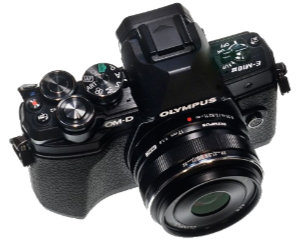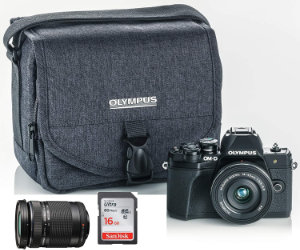 This is a PIP: a Pandemic Inspired Purchase. It has pre-pandemic roots, but it was the lack of travel and its associated reasons to take pictures that triggered the purchase of another device for taking them. I know that’s not very logical but I think quite a bit of what we did, and continue to do, during the COVID-19 pandemic is like that — especially what we purchase. I’ll tell about the purchase before I say much about the camera.
This is a PIP: a Pandemic Inspired Purchase. It has pre-pandemic roots, but it was the lack of travel and its associated reasons to take pictures that triggered the purchase of another device for taking them. I know that’s not very logical but I think quite a bit of what we did, and continue to do, during the COVID-19 pandemic is like that — especially what we purchase. I’ll tell about the purchase before I say much about the camera.
There are two sorts of those pre-pandemic roots I mentioned. One is my experience with Olympus in the days before the digital revolution. I was extremely satisfied with the two OM-1s I owned. The wonderfully small size was one reason; reliability was another. A third reason, and one that I never missed an opportunity to mention, was their lack of dependence on battery power. Yes, a battery was required for the built-in meter, but everything else, including focus and shutter, was manual and would function just fine with a dead battery. I guess that’s the same sort of thinking that had me using only cameras with standard AA or AAA batteries for so long after I left 35mm film behind.
The second root can be traced to my curiosity about the new breed of “mirrorless” cameras even though I dislike the name for the same reason I dislike the label “unleaded gas”. The idea of feeding an electronic viewfinder with the same information going to the image recording sensor makes sense but my experience with the concept had not been encouraging. I’d owned a couple of what used to be called “bridge” cameras because (I think) they bridged the gap between compact cameras and DSLRs. They were practical and yielded satisfactory images, but the sluggishness and low resolution of the eye-level viewfinders left me unimpressed. Curiously, I didn’t whine about it in any of the bridge camera My Gear posts (DMC-FZ5, DMC-FZ8, DMC-FZ70). I did mention the sluggishness of the DMC-ZS40 despite it being much improved from the older cameras. By then I’d gotten used to a real SLR again. I now got to wondering just how good were the EVFs in these even newer offerings?
With that background, two things converged in the stay-at-home days of 2020 to make the purchase happen. One was my constantly walking past two containers of coins in my bedroom. For a little more than twenty years, they had frequently, though not regularly, received handfuls of pocket change. The largest, a jug I’d started on after a snack can had become full, was too heavy to move, and I asked myself just what the purpose was. When I’d started the hoards, the possibility of one day dumping them out for gas or groceries was real. That really was no longer the case, and, unable to explain to myself why they were there, I decided to empty them. I began taking the coins to a nearby counting machine where I had the option of getting 93% of their value in cash or 100% of their value in Amazon credit. I went for all the value all the time. Then, just as my Amazon credit balance was reaching an all-time high, Olympus announced a new E-M10IV and folks started discounting E-M10IIIs.
 I am surprised to see that Olympus still offers the OM-D E-M10 Mark IIIs (not sure what the ‘s’ means) with a 14-40mm lens for $600. The E-M10 Mark IV is available with the same lens for $700. In September 2020, I bought the pictured kit, which includes a 40-150mm lens that Olympus currently offers for $200, for $598 in what was once pocket change. The included case and SD card were icing.
I am surprised to see that Olympus still offers the OM-D E-M10 Mark IIIs (not sure what the ‘s’ means) with a 14-40mm lens for $600. The E-M10 Mark IV is available with the same lens for $700. In September 2020, I bought the pictured kit, which includes a 40-150mm lens that Olympus currently offers for $200, for $598 in what was once pocket change. The included case and SD card were icing.
I was quite impressed when the kit arrived. Although I didn’t list it as a “root”, I think I was just about as curious about the Micro Four Thirds form factor as I was about “mirrorless” viewfinders. The camera’s size reminded me of those distant OM-1 days. Other things about the E-M10 also reminded me of the OM-1 including the general feel and the perceived quality. Photo quality was also good with a sensor of approximately 16 megapixels. With the pancake style 14-40 lens mounted, the camera fits into many pockets and another pocket might hold the 40-150.
So, with all those good things going for it, why has it taken me more than a year to finish this post? The short answer is “lack of use” and the reason for that lack of use is almost the camera’s only negative and it is actually just a personal problem. Even with the tiny size of my cast of cameras, it wasn’t easy finding a role for the E-M10 to play.
The Olympus shares work with a Nikon D5100 and a Panasonic DMC-ZS40. Note that none of these cameras is at all high-end. All three are more or less entry-level for their type. When size is no object, the Nikon wins. It’s hardly the best camera in THE world but it is the best camera in MY world. When size is very much an object, the Panasonic wins. It’s not only the smallest of the three but with a 30X (24–720 mm equivalent) zoom, it is the most versatile. Of course, when the word versatile enters the conversation, my Pixel 4a phone demands attention. It’s almost always at hand and I must reluctantly admit that it does a mighty fine job of taking pretty good pictures in pretty bad situations.
I did find a role for the Olympus during my most recent road trips, but before I reveal what that is I’m going to get in a couple of digs. One is the major flare seen with backlit subjects. This is something it shares with the Panasonic and I theorized it was due to their smallish sensor size. I haven’t totally thrown that possibility out but people more knowledgeable than me have suggested it might be lens quality. The actual problem at the heart of my second dig was operator error but the camera encouraged it. At a point when I really intended to seriously put the camera to use, I found the camera’s field of view so narrow that I simply scrapped my plans and used the Nikon in situations I had thought to use the Olympus. I blamed this on the Micro Four Thirds system. I eventually figured out that the default setting of the rather prominent Fn2 button is to activate 2X digital zoom and that I had apparently pressed it at some point. It was a misunderstanding brought on by unfamiliarity with the camera (which I’m still drenched in) but it was irritating nonetheless.
That role I found for the Olympus? Car seat companion. I like to take road pictures; always one-handed and often, though not always, through a dirty windshield. Doing this with the Nikon or Pixel is too awkward to even think about except on an empty highway or at a dead stop. The Panasonic is actually pretty good at it — once it’s fired up. But firing it up, even when it is on and just sleeping, is a sluggish affair. When sleeping, the Olympus wakes up rather quickly with a touch of the shutter button. It is a bit heavier than the Panasonic but is nearly the same size with a rear screen that is at least the Panasonic’s equal. Even with my digital zoom interfering faux pas, it was good at this and it became even better once I rectified my goof.
As shown by that digital zoom thing, I’ve made little effort to understand what is obviously a very capable and somewhat complex camera. Heck, there might even be a setting that would vanquish that backlit flare. The Nikon D5100 has been in fairly heavy use for over eight years and I know I still don’t understand half of its capabilities. I don’t expect to master the Olympus E-M10 anytime soon but I do expect to take some OK pictures with it. All in all, I’m pretty happy with my PIP.
